Every internal communicator knows this truth: your internal messages aren’t just about projects, deadlines, or strategy updates. They’re about helping people feel seen, heard, and connected. In this post, we explore the types of internal communication tools IC pros need to fulfill their goals in the workplace.
What does couples therapy have to do with internal communication? More than you’d think. Esther Perel, psychotherapist and author, recently wrote in her Letters from Esther blog, “We used to go to work to make a living. Now we go to work to make meaning.” And in today’s world of hybrid schedules, shifting values, and constant change, meaning is often built through connection, community, and culture.
And how do we foster culture at work? Through internal communication.
Because under most interpersonal issues (at home or at work), needs are at play: respect, recognition, care, and trust. That’s where internal communication tools come in. They’re not just for sending messages, they’re for building relationships. And in 2025, relationship-building isn’t a soft skill…it’s a business strategy.
Take a self-guided tour of ContactMonkey
See how our key features can streamline your internal communications.
Take product tour
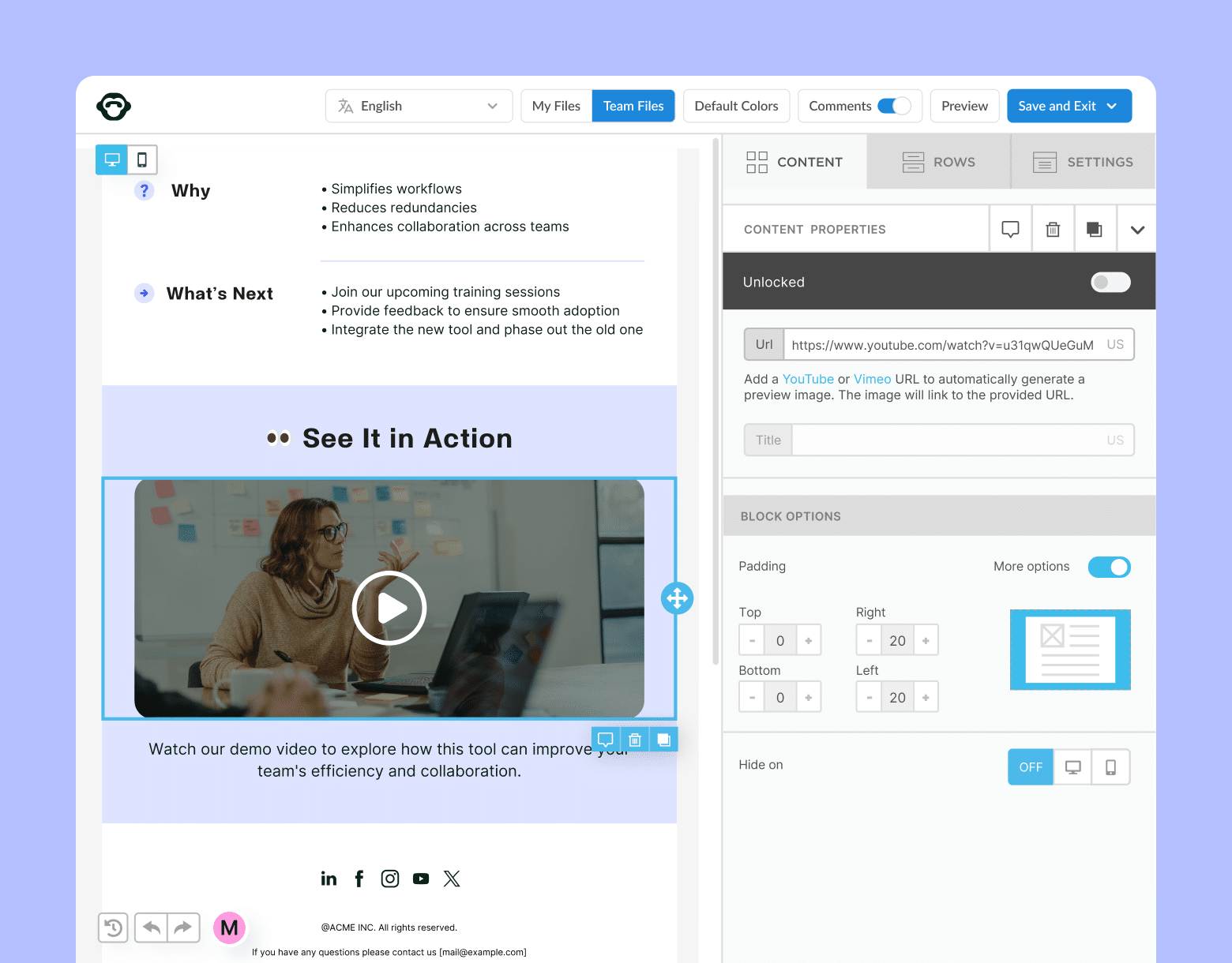
What Is Internal Communication?
Internal communication refers to the methods, channels, and tools organizations use to share information, foster engagement, and build culture across teams and departments.
It includes everything from internal emails to video calls to intranet portals, and choosing the right stack of internal communication tools can drastically improve how employees interact with one another and leadership. Read this internal communications guide to learn more about the craft this year.
Benefits of Effective Internal Communication Tools
The right stack of tools for internal communication can radically improve how your teams function, feel, and perform.
Top benefits include:
- Stronger culture and sense of belonging.
- Faster decision-making and fewer silos.
- Increased transparency and alignment.
- Higher employee engagement and retention.
- Easier measurement of internal campaign success.
- Scalable communication across global, hybrid, or deskless teams.
Why Invest in Modern Internal Comms Tools?
Gone are the days of one-size-fits-all intranets or mass emails with no tracking. Today’s employees expect company internal communication tools that are just as intuitive, mobile-friendly, and personalized as the tools they use outside of work.
Here’s why companies are modernizing their internal comms tools:
- People want more than updates, they want connection.
- You can’t improve what you can’t measure.
- Two-way communication builds trust.
- Better communication = better decision-making.
- Hybrid teams need consistent, inclusive channels.
- Tools help communicators do more with less.
What Does an Internal Communication Tech Stack Look Like?
Whether you’re a startup with 25 employees or a global enterprise with 25,000, the tools you use to communicate shape your culture, alignment, and employee experience.
And while your stack may grow over time, email remains the foundation, no matter your size.
Small companies (1–100 employees)
Lean, but powerful. Focused on flexibility.
- Internal email tool (for announcements, updates, onboarding).
- Messaging app like Slack or Microsoft Teams.
- Cloud-based docs (Google Workspace, Microsoft 365).
- Optional: simple survey tool (Google Forms, Typeform).
Why email matters: Even in small teams, not everyone is online at the same time. Email ensures updates are seen, recorded, and accessible, especially for part-time, deskless, or hybrid employees.
BONUS: If you’re still considering your external email tool for internal comms, check out this guide on marketing tools vs internal communications tools to understand the pros and cons.
Mid-sized companies (100–1,000 employees)
More structure, more segmentation, more need for insights.
- Internal email platform with tracking and personalization (like ContactMonkey).
- Survey & feedback tools for engagement checks.
- Chat + collaboration tools (Slack, Teams, Notion, Miro).
- Company intranet for policies and documents.
- Optional: recognition or engagement platform.
Why email matters: You can’t rely on chat tools alone. With growing teams and multiple departments, email helps you personalize messaging, track engagement, and build communication consistency at scale.
Large enterprises (1,000+ employees)
Complex, distributed, global. Culture becomes intentional.
- Enterprise-grade internal email tool (segmentation, analytics, automation).
- Integrated employee feedback tools + survey systems.
- Intranet with SSO + personalization.
- Collaboration suites with project/task tools.
- Recognition, learning, and onboarding platforms.
- Crisis comms system or SMS alerts.
Why email matters: At this scale, email is the only guaranteed, measurable channel that reaches every employee, no matter their role, device, or location. It’s the backbone of every major internal communication plan.
Get powerful send features with ContactMonkey
Create custom audiences, increase content relevancy, and improve employee email engagement.
Learn more
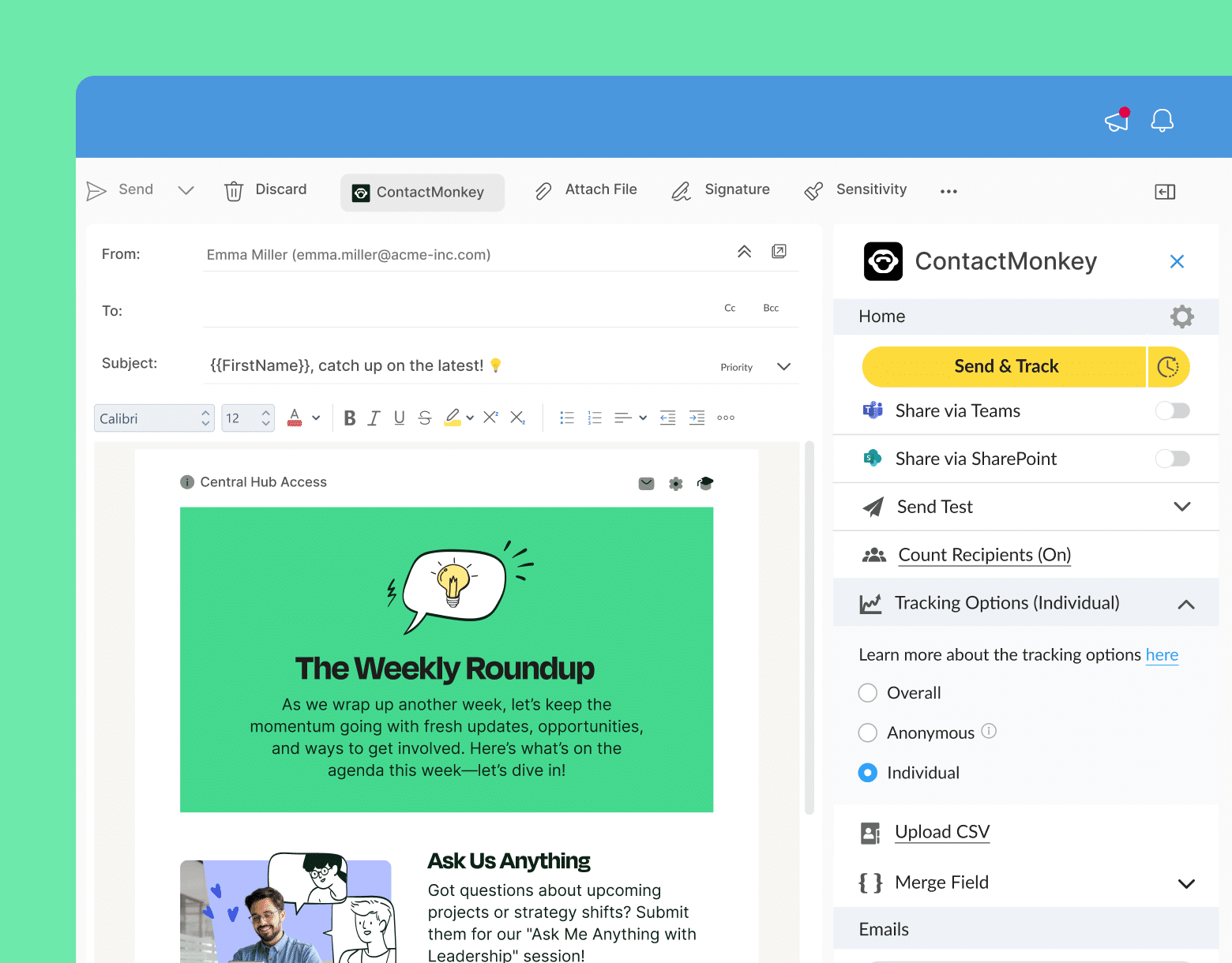
TL;DR: Email is non-negotiable
Regardless of your company’s size or maturity, email is the only channel that’s:
- Universal
- Reliable
- Measurable
- Professional
- Secure
- Scalable
From scrappy startup to global enterprise, your tech stack will evolve, but email stays essential.
15 Types of Internal Communication Tools to Use in 2025
Here are the 15 most important internal communication tools to have in your company’s stack this year, along with what they are, why they matter, and who does them best.
1. Internal email tools
What it is: A central channel for employee communication, especially for announcements, updates, or leadership messaging.
Why it matters: Still one of the most effective channels, when done right. But most traditional email tools don’t give you the insights you need when compared to an advanced email tool.
Why invest in this type of internal communication tool:
- Track opens, clicks, read time, and device type.
- Personalize by department, role, or location.
- Eliminate guesswork with analytics dashboards.
Example: ContactMonkey integrates with Outlook and Gmail, helping internal comms teams create branded, responsive emails with engagement tracking built-in.
Best for: Reaching both desk and deskless employees with measurable, targeted messaging.
2. Employee newsletter tools
What it is: A tool for creating visually engaging, regularly scheduled internal newsletters.
Why it matters: Keeps employees in the loop, supports transparency, and reinforces company culture.
Why invest in this type of internal communication tool:
- Easy drag-and-drop builders.
- Feedback and survey blocks.
- Newsletter analytics and optimization.
Example: ContactMonkey lets you build and send personalized newsletters without leaving your inbox and without relying on design or IT support.
Best for: Sharing consistent updates and building transparency across teams and locations.
3. Employee survey tools
What it is: Platforms that collect employee feedback through pulse surveys, polls, or engagement check-ins.
Why it matters: Helps you listen, adapt, and respond to employee needs.
Why invest in this type of internal communication tool:
- Build two-way communication loops.
- Segment feedback by team or tenure.
- Benchmark engagement over time.
Example: ContactMonkey allows you to embed pulse surveys and feedback polls directly into your emails, so you can collect real-time insights without needing a separate survey tool.
Best for: Gathering real-time employee sentiment and creating two-way communication loops.
Start two-way conversations and employee feedback loops
Learn how to engage staff with pulse surveys, content ratings and reactions, custom polls, and more. Ready to send modern emails?
See engagement features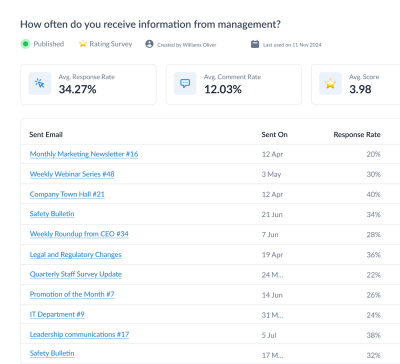
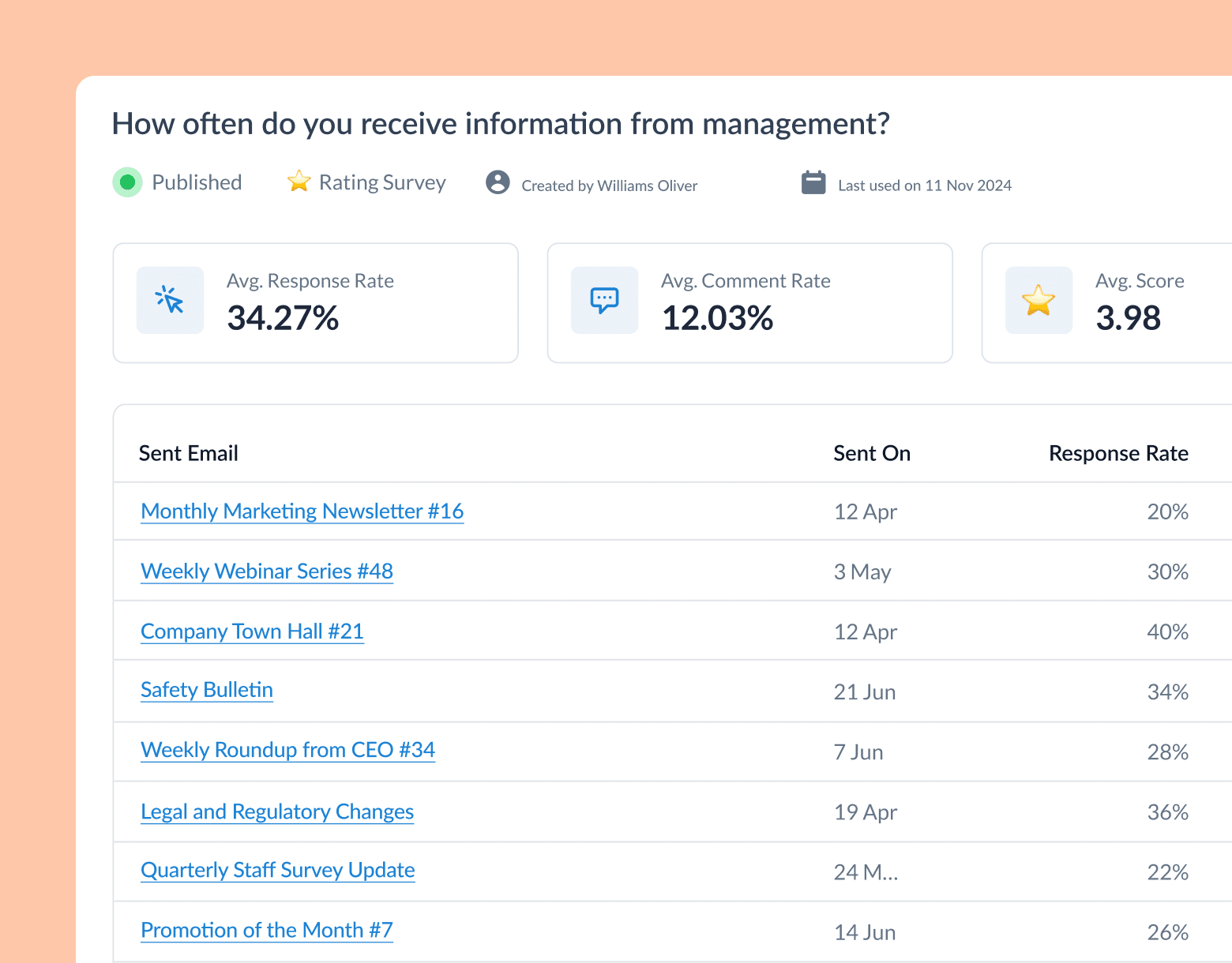
4. Collaboration tools
What it is: Internal collaboration tools enable real-time and asynchronous communication across teams and departments.
Why it matters: Speeds up workflows and reduces reliance on endless email threads.
Why invest in this type of internal communication tool:
- Foster transparent team discussions.
- Encourage cross-functional collaboration.
- Integrate with task and file-sharing platforms.
Example: Slack offers real-time messaging, file sharing, and searchable conversation history, making it easy for teams to collaborate instantly across projects and departments.
Best for: Encouraging cross-functional teamwork and reducing email clutter.
5. Instant messaging & chat tools
What it is: Real-time communication tools for quick updates, check-ins, and informal team banter.
Why it matters: Builds immediacy, reduces lag, and keeps teams nimble.
Why invest in this type of internal communication tool:
- Create dedicated channels by project or team.
- Share files, reactions, and GIFs.
- Encourage relationship-building with quick communication.
Example: Microsoft Teams combines chat, video, and document collaboration in one platform, keeping internal communication seamless across hybrid teams.
Best for: Fostering informal, real-time connections and quick team decision-making.
6. Video conferencing platforms
What it is: Tools for virtual meetings, town halls, and company-wide events.
Why it matters: Helps humanize communication, especially in hybrid or remote workplaces.
Why invest in this type of internal communication tool:
- Share screens, record meetings, and use transcripts.
- Host virtual all-hands or leadership Q&As.
- Build connection through face-to-face engagement.
Example: Zoom enables high-quality virtual meetings, town halls, and webinars, helping distributed teams connect face-to-face no matter where they’re located.Best for: Hosting engaging virtual meetings, town halls, and leadership Q&As.
7. Intranet platforms
What it is: A centralized knowledge base for policies, updates, and resources.
Why it matters: Reduces confusion and provides a “single source of truth.”
Why invest in this type of internal communication tool:
- Organize documents and company news.
- Provide onboarding and HR resources.
- Make information searchable and accessible.
Example: LumApps is a modern intranet solution that centralizes internal news, policies, and resources in one customizable, easy-to-navigate hub.
Best for: Providing a centralized hub for important resources, updates, and self-service access.
8. Project & task management tools
What it is: Systems that track assignments, timelines, and progress across teams.
Why it matters: Supports alignment, accountability, and cross-team visibility.
Why invest in this type of internal communication tool:
- Create workflows and assign owners.
- Connect communication with action.
- Integrate with Slack, email, or calendars.
Example: Asana helps teams plan, prioritize, and track project progress with visual timelines, task assignments, and real-time updates, all in one place.
Best for: Aligning teams around deadlines, responsibilities, and shared goals.
9. Employee recognition tools
What it is: Platforms that allow employees and managers to give praise and celebrate milestones.
Why it matters: Recognition is one of the most overlooked—but powerful—ways to engage teams.
Why invest in this type of internal communication tool:
- Increase retention and morale.
- Tie recognition to values and goals.
- Encourage peer-to-peer praise.
Example: Bonusly makes it easy for employees to recognize peers and celebrate milestones through a points-based reward system tied to company values.
Best for: Reinforcing company values and boosting morale through peer and manager recognition.
10. Crisis communication & emergency alerts
What it is: Tools designed to send urgent updates and critical alerts in real time.
Why it matters: When minutes matter, communication must be instant and reliable.
Why invest in this type of internal communication tool:
- Reach employees via SMS, email, or push notifications.
- Track delivery and acknowledgment.
- Automate escalation workflows.
Example: ContactMonkey’s SMS Communication feature lets you send urgent updates via email or SMS, with read-tracking and delivery analytics built-in to ensure your message lands when it matters most.
Best for: Sending urgent, multi-channel updates during critical incidents or time-sensitive events.
11. Employee advocacy platforms
What it is: Tools that empower employees to share branded content, company news, or job postings on their personal social networks.
Why it matters: When employees advocate for your organization, they amplify your brand message and increase trust—internally and externally.
Why invest in this type of internal communication tool:
- Encourage a sense of ownership and pride.
- Boost reach and visibility on social media.
- Track engagement and participation.
Example: EveryoneSocial helps employees share approved content while giving internal comms full visibility into performance and reach.
Best for: Turning employees into brand ambassadors and amplifying internal messages externally.
12. Enterprise social networks
What it is: Internal platforms that mimic public social networks, allowing employees to post updates, engage in discussions, and build connections.
Why it matters: These networks help build culture, promote knowledge-sharing, and strengthen cross-team relationships.
Why invest in this type of internal communication tool:
- Promote informal communication and community-building.
- Enable peer-to-peer recognition and collaboration.
- Support remote teams with social connection.
Example: Yammer (by Microsoft) functions like a private social network for organizations, fostering conversation and visibility across all levels of the company.
Best for: Driving engagement and building community across large or distributed workforces.
13. Digital signage tools
What it is: Tools that display rotating content (like announcements, KPIs, or event reminders) on screens in offices, factories, or shared spaces.
Why it matters: Visual communication captures attention, especially in environments where employees aren’t always checking email or chat.
Why invest in this type of internal communication tool:
- Increase visibility of important updates.
- Engage deskless or frontline employees.
- Reinforce branding, goals, and culture.
Example: Appspace allows internal comms teams to display key messages, videos, or metrics on digital displays in real time.
Best for: Reaching employees in physical spaces where email or chat might not be practical.
14. Internal podcasts
What it is: Audio series created by internal comms or leadership teams to share updates, stories, or behind-the-scenes content.
Why it matters: Podcasts offer a more personal, on-the-go format that fosters connection, especially in remote or hybrid settings.
Why invest:
- Humanize leadership and messaging.
- Create an “always-on” channel for updates.
- Reach employees during commutes or screen breaks.
Example: Storyboard is a secure internal podcasting platform that allows teams to distribute episodes privately, with listener analytics and mobile access.
Best for: Building connection and culture through authentic, story-driven communication.
15. Employee apps
What it is: All-in-one mobile apps that combine internal news, HR resources, surveys, chat, and alerts into a single hub.
Why it matters: With mobile-first workforces and deskless employees, centralized mobile access is essential for engagement and communication.
Why invest:
- Deliver push notifications directly to employees.
- Centralize access to comms, resources, and feedback tools.
- Enable communication across any location or device.
Example: Workvivo offers a branded employee app that integrates company news, community engagement features, and HR tools to create a connected digital workplace.
Best for: Reaching remote, mobile, or frontline teams who may not have access to a desktop.
Build engaging, interactive employee emails in minutes
Build amazing emails quickly and easily using our drag-and-drop template builder. No design or technical expertise needed.
Explore email builder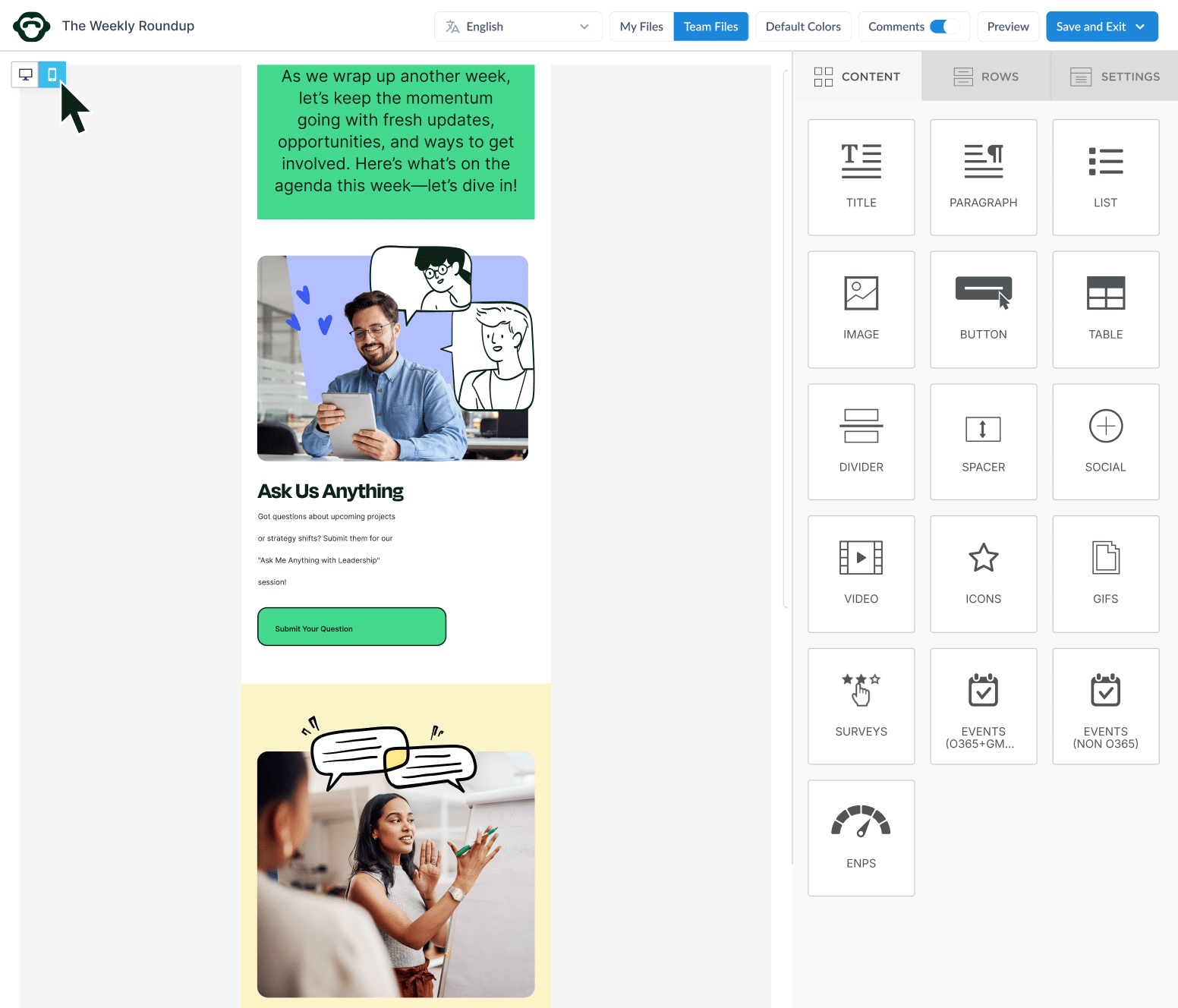
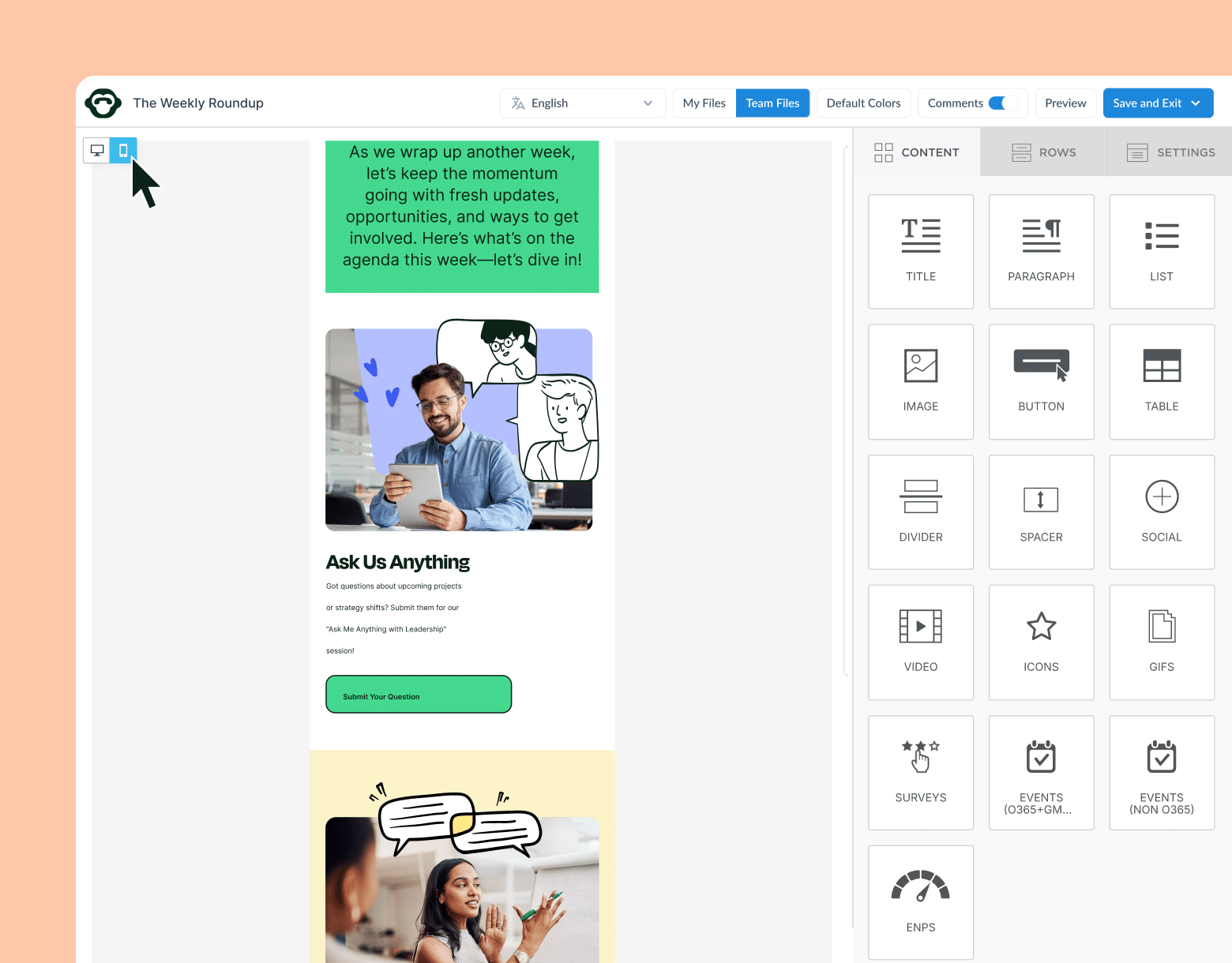
Raising the Relational Index of Work
In 2025, internal communication tools are both operational and relational.
They don’t just move messages; rather, they create trust, culture, and connection.
Why this matters:
- Every email, update, or survey is a signal to your team: “You matter. We’re in this together.”
- Employees want more than information; they want to feel seen, heard, and valued.
- Culture isn’t built in meetings or policy documents. It’s built through everyday communication.
Where ContactMonkey comes in:
ContactMonkey helps you shape that culture, one message at a time.
- Create engaging, branded internal emails.
- Build consistent employee newsletters.
- Launch pulse surveys and feedback loops.
- Get real-time analytics to understand what’s working.
- Close the loop with targeted, data-driven follow-ups.
It’s everything you need to build connection, not just communication.
How to start:
- Start with internal employee email.
- Layer in feedback and employee surveys.
- Use analytics to guide strategy.
- Lead with empathy and intent.
Because at the end of the day, communication is how culture gets built.
Ready to build a more connected workplace? Book a 15-minute call with ContactMonkey to see how our all-in-one internal communication platform helps you engage employees, gather feedback, and build a stronger culture…right from your inbox.



